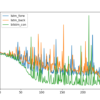Bidirectional LSTMs are an extension of traditional LSTMs that can improve model performance on sequence classification problems. In problems where all timesteps of the input sequence are available, Bidirectional LSTMs train two instead of one LSTMs on the input sequence. The first on the input sequence as-is and the second on a reversed copy of […]










